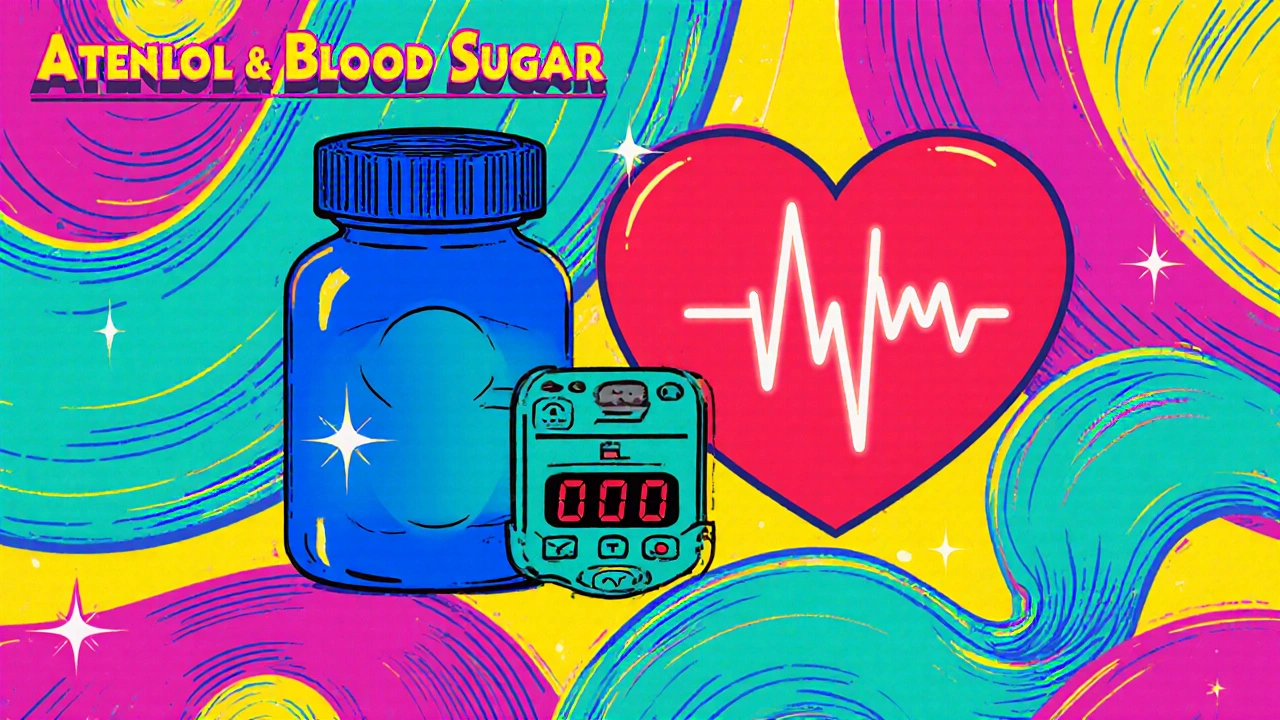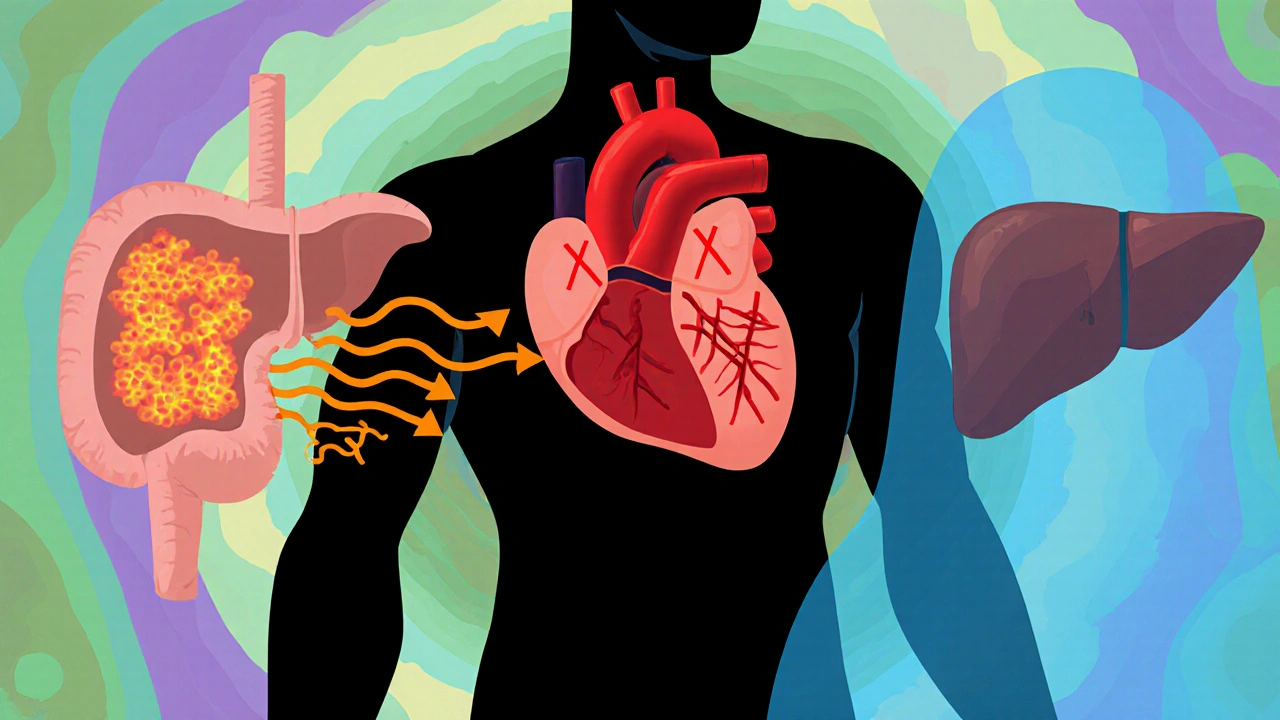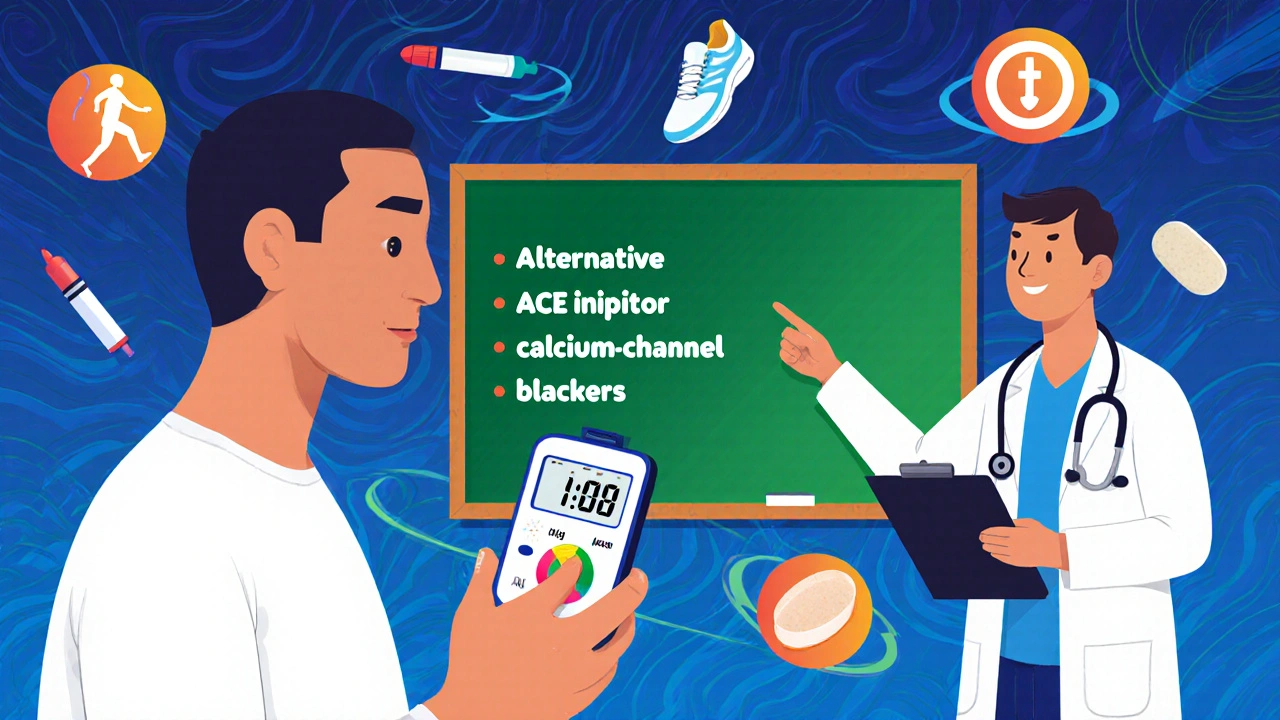
Atenolol Blood Sugar Tracker
Enter Your Reading
Your Tracking Summary
Monitor patterns to detect hidden hypoglycemia. Atenolol can mask symptoms of low blood sugar.
Your Blood Sugar History
When you hear the name Atenolol is a cardio‑selective beta‑blocker used to treat high blood pressure and heart rhythm problems, you might wonder how it plays with your daily blood‑sugar numbers. Blood Sugar refers to the concentration of glucose circulating in your bloodstream, usually measured in mg/dL is the lifeline for anyone living with diabetes. The question is: does taking atenolol make it harder to keep those numbers steady? Let’s break it down in plain language, point out the real risks, and give you practical steps you can take with your doctor.
How Atenolol Works in the Body
Atenolol belongs to the beta‑blocker family. It blocks beta‑1 receptors in the heart, slowing the heartbeat and lowering the force of each beat. This reduces blood pressure and eases strain on the heart. Because it’s “cardio‑selective,” it has less impact on beta‑2 receptors found in the lungs and blood vessels, which means fewer breathing side‑effects compared to non‑selective beta‑blockers.
Why Blood Sugar Can Change on Beta‑Blockers
Beta‑blockers can affect glucose metabolism in three ways:
- Masking hypoglycemia symptoms: The usual warning signs-fast heartbeat, tremor, sweating-are dampened, so low blood sugar can sneak up on you.
- Altering insulin release: Beta‑2 receptors help pancreatic beta cells release insulin. Blocking them may blunt that response, especially with non‑selective agents.
- Impact on glycogenolysis: The liver’s ability to break down glycogen into glucose is partially controlled by the sympathetic nervous system. Beta‑blockers can blunt this emergency glucose boost.
For Atenolol, the effect on blood sugar is usually milder because it mainly targets beta‑1 receptors. Still, the risk isn’t zero, especially in people on insulin or sulfonylureas.
What Diabetics Should Watch For
Here are the red flags that signal atenolol may be messing with your glucose control:
- Sudden drops in HbA1c trends without a clear reason (could hint at hidden hypoglycemia).
- Unexplained spikes after meals, even when you stick to your usual carb count.
- Feeling unusually fatigued or confused after physical activity-these could be low‑sugar episodes that you can’t feel.
- Frequent need to adjust insulin doses or oral hypoglycemics within weeks of starting atenolol.
If any of these show up, it’s time to talk to your healthcare team.

Managing Blood Sugar While on Atenolol
Don’t panic-most people can stay safe with a few simple habits:
- Check glucose more often: Add a pre‑exercise and post‑exercise reading for the first month after you start the medication.
- Keep a symptom log: Write down any dizziness, sweating, or unusual fatigue. Even if you can’t feel low sugar, the pattern matters.
- Adjust medication timing: Some clinicians move the atenolol dose to the evening to avoid daytime hypoglycemia confusion.
- Coordinate with your diabetes meds: If you’re on insulin, a slight reduction in basal dose may smooth things out. Always do this with a doctor’s guidance.
- Know your rescue plan: Carry fast‑acting glucose (tablets or juice) and let family members know that beta‑blockers can hide low‑sugar signs.
Alternative Blood‑Pressure Options for Diabetics
If atenolol proves tricky, discuss these alternatives with your doctor. They tend to have a neutral or even beneficial effect on glucose:
| Beta‑Blocker | Typical Dose | Glycemic Effect | Preferred for Diabetics? |
|---|---|---|---|
| Atenolol | 25‑100mg daily | Low‑to‑moderate (mostly neutral) | Yes, with monitoring |
| Metoprolol | 50‑200mg daily | Moderate (can raise glucose) | Use cautiously |
| Propranolol | 40‑160mg daily | High (blocks beta‑2, raises glucose) | Usually avoid in diabetes |
| Carvedilol | 6.25‑25mg daily | Neutral to slight increase | Acceptable with monitoring |
Other classes-like ACE inhibitors, ARBs, or calcium‑channel blockers-generally have no direct impact on glucose and are often first‑line for diabetics with hypertension.

Talking to Your Doctor: The Right Questions
Bring these questions to your next appointment:
- “How will atenolol affect my insulin or metformin dosing?”
- “Should I schedule more frequent glucose checks for the first few weeks?”
- “Are there alternative blood‑pressure meds that won’t interfere with my blood‑sugar control?”
- “What signs of hidden hypoglycemia should I watch for while on a beta‑blocker?”
Having a clear plan reduces anxiety and keeps both your heart and pancreas happy.
Key Takeaways
- Atenolol is a cardio‑selective beta‑blocker that can mildly affect blood sugar, mainly by masking low‑sugar symptoms.
- Watch for unexpected glucose spikes, hidden hypoglycemia, and sudden medication adjustments.
- Increase glucose monitoring, keep a symptom log, and coordinate any dosage changes with your clinician.
- If atenolol proves problematic, alternatives like ACE inhibitors or calcium‑channel blockers are viable options.
Frequently Asked Questions
Can atenolol cause low blood sugar?
Atenolol itself rarely drops glucose levels, but it can hide the warning signs of hypoglycemia, making low sugar harder to detect.
Do I need to stop atenolol if I have diabetes?
Not automatically. Many diabetics use atenolol safely with close glucose monitoring and occasional dose tweaks. Talk to your doctor before making any changes.
How often should I check my blood sugar after starting atenolol?
For the first two weeks, check before meals, two hours after meals, and before bedtime. If stable, you can taper back to your usual schedule.
Are there beta‑blockers that are safer for diabetics?
Carvedilol and acebutolol tend to have a more neutral effect on glucose. Non‑selective agents like propranolol are generally avoided unless absolutely necessary.
What should I do if I suspect hidden hypoglycemia?
Treat it like any low‑sugar event: consume 15‑20g of fast‑acting carbohydrate (glucose tablets, juice), re‑check in 15 minutes, and call your healthcare provider if symptoms persist.
14 Comments
Robert Gilmore October 17, 2025 AT 14:53
I don’t see why anyone makes a fuss about atenolol and sugar-it's barely a blip.
Robert Gilmore October 19, 2025 AT 08:33
Hey, good point about monitoring. If you start atenolol, add a few extra fingersticks for the first two weeks and compare those numbers to your baseline. That way you’ll catch any hidden dips before they become a problem.
Robert Gilmore October 20, 2025 AT 20:40
Behold, the heart’s silent sentinel, Atenolol, stalks the arteries like a weary philosopher pondering the void-does it not also whisper to the pancreas? Some claim it merely masks the tremor of hypoglycemia, yet others argue it reshapes the very alchemy of insulin release. In the theater of medicine, every drug takes a bow, but the curtain may hide a silent chorus of glucose fluctuations. Thus, the seeker must wield a glucometer as a lantern in the night, lest the shadows deceive.
Robert Gilmore October 22, 2025 AT 06:00
Dear reader, it is essential to approach this matter with both vigilance and optimism. By maintaining diligent glucose logs and consulting your clinician regularly, you can harmonize cardiovascular health with glycemic control.
Robert Gilmore October 23, 2025 AT 12:33
Keeping an eye on your blood sugar after starting the med is a smart move. A few extra checks won’t hurt.
Robert Gilmore October 24, 2025 AT 16:20
This whole atenolol hype is a sham made by big pharma to keep us hooked! It’s nonsense and you should dump it before it messes with your sugar levels!!!
Robert Gilmore October 25, 2025 AT 17:20
Honestly, I think the warnings are overblown-most people never notice any change. If you’re terrified of a minor blip, you’re missing the bigger picture of treating hypertension effectively. Stop fretting and just take the pill.
Robert Gilmore October 26, 2025 AT 15:56
I hear you, the fear of hidden lows can be unsettling 😔. Remember, you’re not alone-many diabetics navigate this and come out fine with a solid plan. Keep that glucometer close and trust your instincts.
Robert Gilmore October 27, 2025 AT 14:10
What if the pharma giants want us to stay dependent on meds, tweaking our glucose just enough to keep us buying more supplements? The subtle shift in blood sugar could be a deliberate control mechanism, hidden behind clinical studies. Stay vigilant.
Robert Gilmore October 28, 2025 AT 11:00
According to the latest endocrinology guidelines, atenolol’s impact on glycemic control is modest but not negligible. Clinicians should adjust insulin regimens accordingly and advise patients on increased monitoring frequency.
Robert Gilmore October 29, 2025 AT 06:26
Oh yes, because everyone loves another mystery in their diabetes management.
Robert Gilmore October 30, 2025 AT 00:30
We are told to trust the system, yet the system tells us to trust the system. The paradox of a beta‑blocker that both shields the heart and clouds the warning signs is a perfect metaphor for modern medicine’s double‑edged sword. Question everything.
Robert Gilmore October 30, 2025 AT 17:10
When I first encountered the discussion about atenolol and its subtle dance with blood sugar, I felt a surge of curiosity that bordered on obsession. The literature, dense with clinical trials, paints a picture of a medication that is both a guardian of cardiovascular stability and a potential cloaker of hypoglycemic signals. One must first acknowledge the pharmacological elegance of cardio‑selectivity, which spares the lungs while taming the heart's over‑exertion. Yet, beneath this elegance lies a mechanistic pathway wherein beta‑1 blockade can indirectly influence hepatic glucose output. The liver, a steadfast reservoir of glycogen, relies on sympathetic cues that are muted when beta receptors are inhibited. Consequently, the emergency release of glucose during stress may be blunted, leaving patients vulnerable to unseen dips. Clinicians, aware of this nuance, often recommend a temporary escalation of self‑monitoring frequency, a pragmatic compromise. From a patient’s perspective, the added fingersticks can feel burdensome, but they serve as a lighthouse in the fog of altered physiology. Moreover, the psychological impact of masked hypoglycemia cannot be dismissed; anxiety may replace the usual physical alarms. This shift underscores the importance of education, ensuring that individuals recognize alternative cues such as sudden fatigue or mental clouding. Dietary adjustments, such as modestly increasing complex carbohydrates at bedtime, can provide a safety net without compromising cardiovascular goals. Pharmacists, too, play a pivotal role, advising on timing of doses – many find evening administration reduces daytime uncertainty. It is also worth noting that alternative antihypertensives, like ACE inhibitors, present a neutral glycemic profile and may be preferable for some. Nevertheless, for patients who tolerate atenolol well, the benefits often outweigh the manageable risks. In the grand tapestry of chronic disease management, balance is the thread that weaves together heart health and glucose stability. Thus, with diligent monitoring, open communication with healthcare providers, and a willingness to adapt, one can navigate this complex interplay successfully.
Robert Gilmore October 31, 2025 AT 08:26
Wow that was a lot of info – I cant even keep up lol. Nice job but maybe cut it down a bit next time.